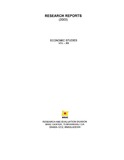Patterns and trends in food consumption in poor urban and rural households in Bangladesh: cluster analysis of household survey data
Citation
Halder, S. R., & Urey, I. (2003, September). Patterns and trends in food consumption in poor urban and rural households in Bangladesh: cluster analysis of household survey data. Research Reports (2003): Economic Studies, Vol – XX, 1–16.Abstract
Objectives: To identify groups within rural and urban Bangladesh demonstrating
similar socio-economic characteristics and food consumption patterns.
Design: A household survey was conducted in a variety of locations m Dhaka
Division to collect information from rural, and urban household. Cluster analysis was
then used to group the households.
Setting: Dhaka Division
Results: The analysis highlighted 5 clusters. Cluster I is categorised as an urban
lifestyle group, with a mixed poverty profile and a transforming consumption pattern.
Cluster 2 is the rural rich also experiencing a transforming consumption pattern.
Cluster 3 IS the poor with a traditional consumption pattern that appears to be
deteriorating in balance. Cluster 6 is the rural less poor group with a traditional
consumption pattern. Cluster 5 is comprised of poor female-headed households with a
traditional consumption pattern, excluded by poverty and status from any dietary
transition.
Conclusions: Household exhibiting a transition in food consumption towards market
sourced, packaged, and new food items tend to be either urban in nature or from
households classified as rich/surplus.
Not only is the diet of the poor not diversifying into these "new food items" but also
the diversity of food from traditional sources is declining, with an increased reliance
on rice and very low expenditure on high protein food items.
There is a distinct dietary pattern for slum dwellers, but female-headed households do
share this pattern and appear to be excluded from any transition by poverty and
cultural barriers.

